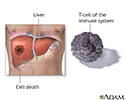Amebic liver abscess
Hepatic amebiasis; Extraintestinal amebiasis; Abscess - amebic liver
Amebic liver abscess is a collection of pus in the liver in response to an intestinal parasite called Entamoeba histolytica .
Causes
Amebic liver abscess is caused by Entamoeba histolytica. This parasite causes amebiasis , an intestinal infection that is also called amebic dysentery. After an infection has occurred, the parasite may be carried by the blood from the intestines to the liver.
Amebiasis
Amebiasis is an infection of the intestines. It is caused by the parasite Entamoeba histolytica.

The disease spreads from eating food or water that has been contaminated with feces (sometimes due to the use of human waste as fertilizer). It is also spread through person-to-person contact.
The infection occurs worldwide, but is most common in tropical areas where crowded living conditions and poor sanitation exist. Africa, Latin America, Southeast Asia, and India have significant health problems from this disease.
Risk factors for amebic liver abscess include:
- Alcoholism
- Cancer
-
Immunosuppression
, including HIV infection
Immunosuppression
Immunodeficiency disorders occur when the body's immune response is reduced or absent.
 ImageRead Article Now Book Mark Article
ImageRead Article Now Book Mark Article - Malnutrition
- Old age
- Pregnancy
- Recent travel to a tropical region
- Steroid use
Symptoms
There are usually no symptoms of intestinal infection. But people with amebic liver abscess do have symptoms, including:
- Abdominal pain, particularly in the right, upper part of the abdomen; pain is intense, continuous or stabbing
- Cough
- Fever and chills
- Diarrhea (in only one-third of patients)
-
General discomfort, uneasiness, or ill feeling (
malaise
)
Malaise
Malaise is a general feeling of discomfort, illness, or lack of well-being.
Read Article Now Book Mark Article - Hiccups that do not stop (rare)
-
Jaundice
Jaundice
Jaundice is a yellow color of the skin, mucus membranes, or eyes. The yellow coloring comes from bilirubin, a byproduct of old red blood cells. Jau...
 ImageRead Article Now Book Mark Article
ImageRead Article Now Book Mark Article - Loss of appetite
- Sweating
- Weight loss
Exams and Tests
Tests that may be done include:
-
Abdominal ultrasound
Abdominal ultrasound
Abdominal ultrasound is a type of imaging test. It is used to look at organs in the abdomen, including the liver, gallbladder, spleen, pancreas, and...
 ImageRead Article Now Book Mark Article
ImageRead Article Now Book Mark Article -
Abdominal CT scan
or MRI
Abdominal CT scan
An abdominal CT scan is an imaging method. This test uses x-rays to create cross-sectional pictures of the belly area. CT stands for computed tomog...
 ImageRead Article Now Book Mark Article
ImageRead Article Now Book Mark Article -
Complete blood count
Complete blood count
A complete blood count (CBC) test measures the following:The number of red blood cells (RBC count)The number of white blood cells (WBC count)The tota...
 ImageRead Article Now Book Mark Article
ImageRead Article Now Book Mark Article - Liver abscess aspiration to check for bacterial infection in the liver abscess
-
Liver scan
Liver scan
A liver scan uses a radioactive material to check how well the liver or spleen is working and to assess masses in the liver.
 ImageRead Article Now Book Mark Article
ImageRead Article Now Book Mark Article -
Liver function tests
Liver function tests
Liver function tests are common tests that are used to see how well the liver is working. Tests include:AlbuminAlpha-1 antitrypsin Alkaline phosph...
 ImageRead Article Now Book Mark Article
ImageRead Article Now Book Mark Article - Blood test for amebiasis
-
Stool testing
for amebiasis
Stool testing
Stool ova and parasites exam is a lab test to look for parasites or eggs (ova) in a stool sample. The parasites are associated with intestinal infec...
 ImageRead Article Now Book Mark Article
ImageRead Article Now Book Mark Article
Treatment
Antibiotics such as metronidazole (Flagyl) or tinidazole (Tindamax) are the usual treatment for liver abscess. A drug such as paromomycin or diloxanide must also be taken to get rid of all the ameba in the intestine and to prevent the disease from coming back. This treatment can usually wait until after the abscess has been treated.
In rare cases, the abscess may need to be drained using a catheter or surgery to relieve some of the abdominal pain.
Outlook (Prognosis)
Without treatment, the abscess may break open (rupture) and spread into other organs, leading to death. People who are treated have a very high chance of a complete cure or only minor complications.
Possible Complications
The abscess may rupture into the abdominal cavity, the lining of the lungs, the lungs, or the sac around the heart. The infection can also spread to the brain.
When to Contact a Medical Professional
Call your health care provider if you develop symptoms of this disease, especially if you have recently traveled to an area where the disease is known to occur.
Prevention
When traveling in tropical countries with poor sanitation, drink purified water and do not eat uncooked vegetables or unpeeled fruit.
References
Petri WA, Haque R. Entamoeba species, including amebic colitis and liver abscess. In: Bennett JE, Dolin R, Blaser MJ, eds. Mandell, Douglas, and Bennett's Principles and Practice of Infectious Diseases . 8th ed. Philadelphia, PA: Elsevier Saunders; 2015:chap 275.
Wolf PS, Park JO. Liver abscess: pyogenic and amebic hepatic abscess. In: Jong EC, ed. Netter's Infectious Diseases . Philadelphia, PA: Elsevier Saunders; 2012:chap 47.
-
Liver cell death - illustration
Organisms that carry disease can travel through the blood stream into the liver and form an abscess, a collection of infected tissue and pus.
Liver cell death
illustration
Review Date: 5/1/2015
Reviewed By: Jatin M. Vyas, MD, PhD, Assistant Professor in Medicine, Harvard Medical School; Assistant in Medicine, Division of Infectious Disease, Department of Medicine, Massachusetts General Hospital, Boston, MA. Also reviewed by David Zieve, MD, MHA, Isla Ogilvie, PhD, and the A.D.A.M. Editorial team.

